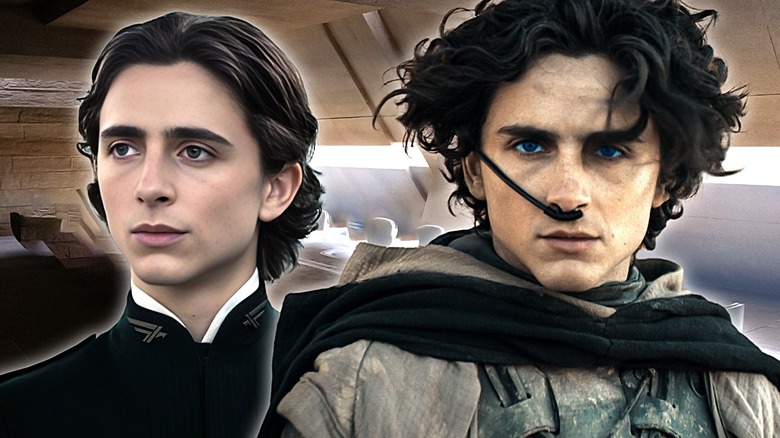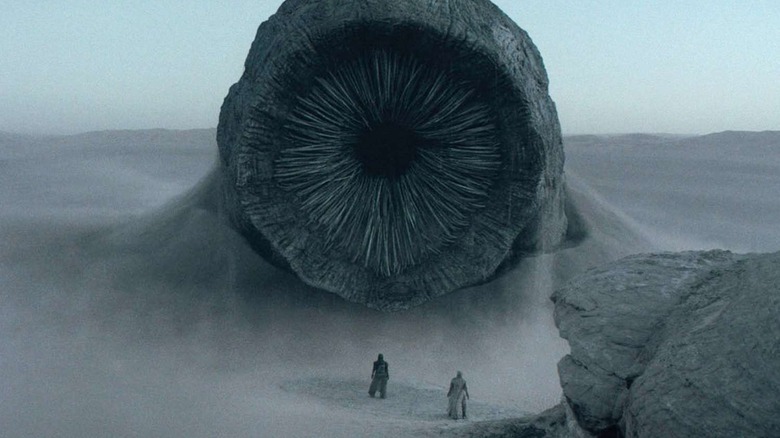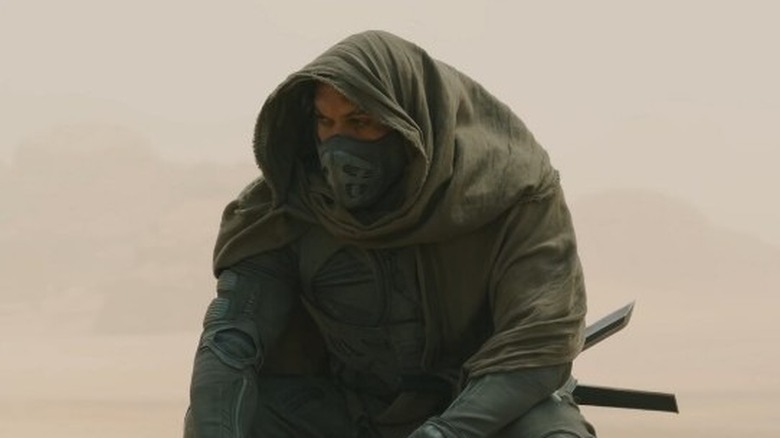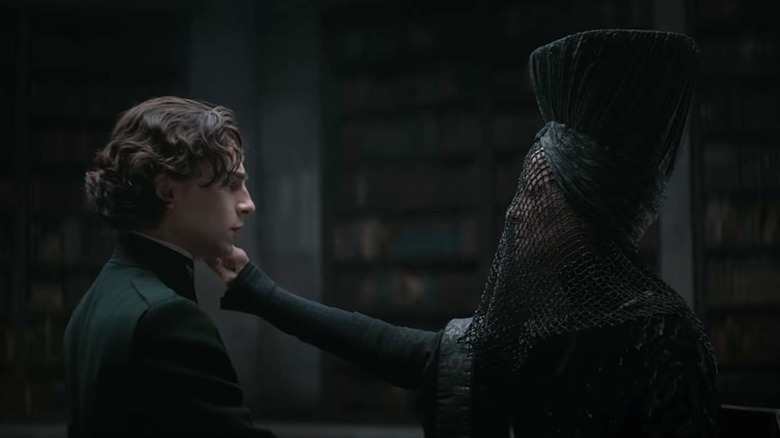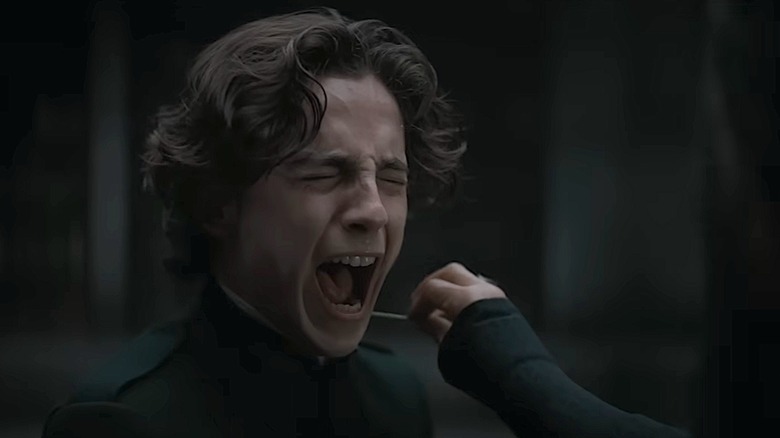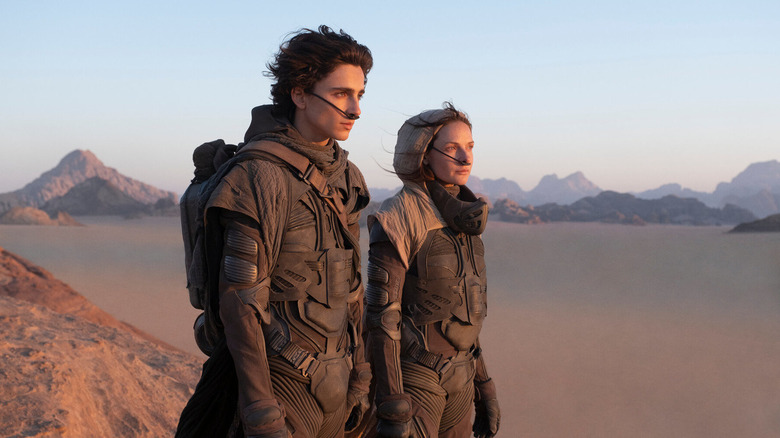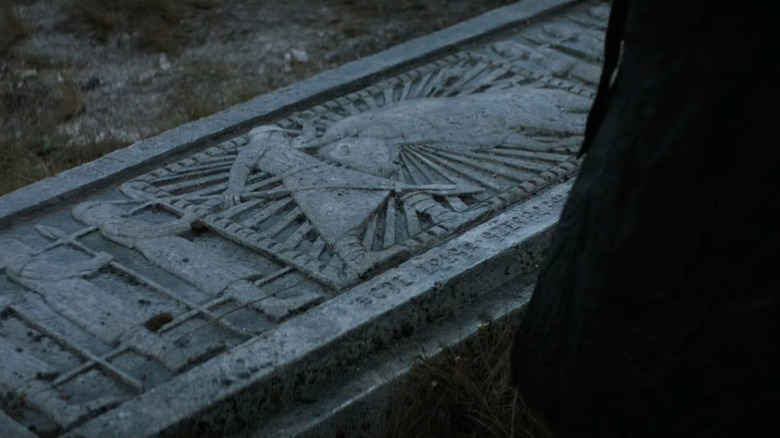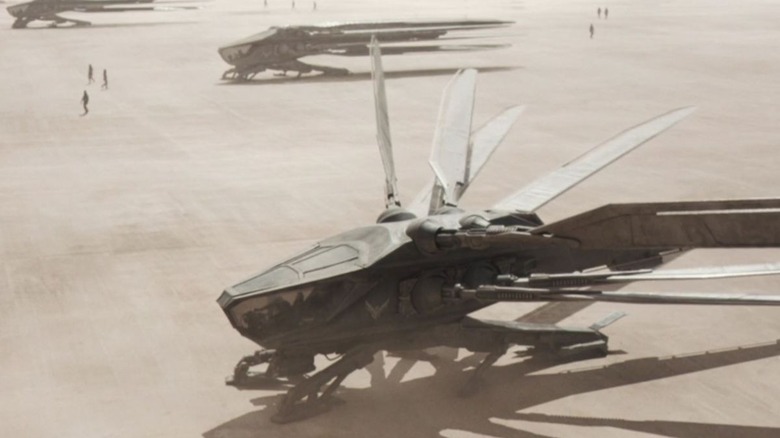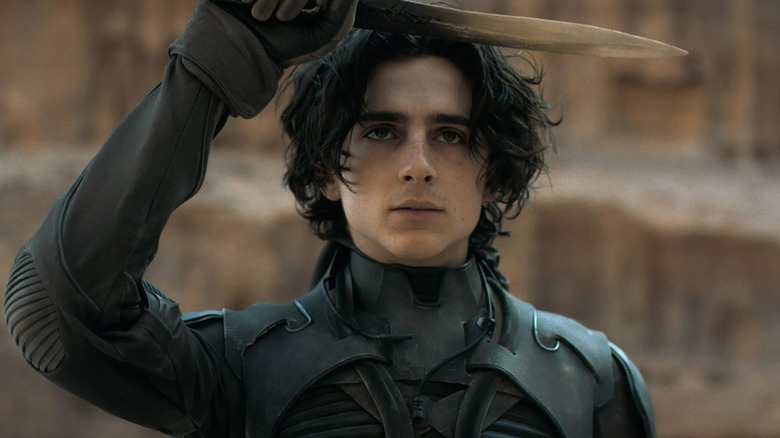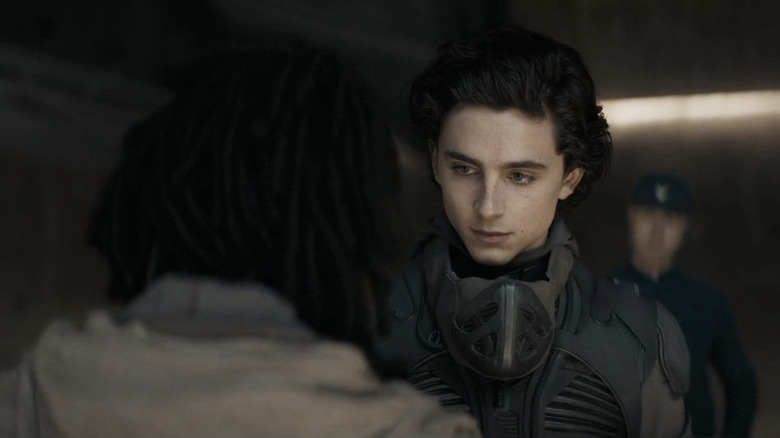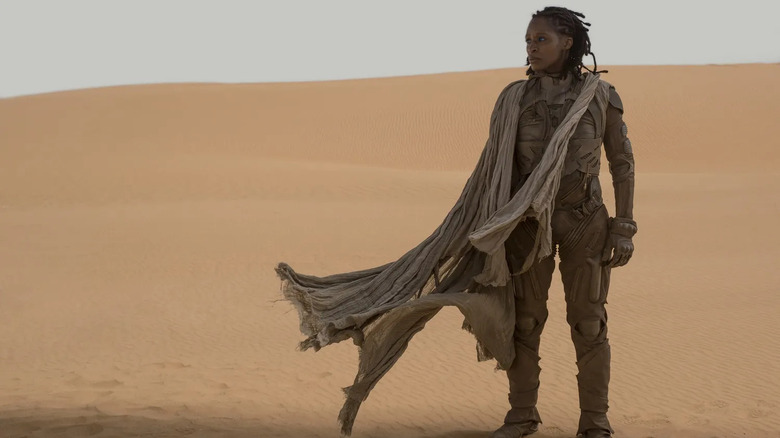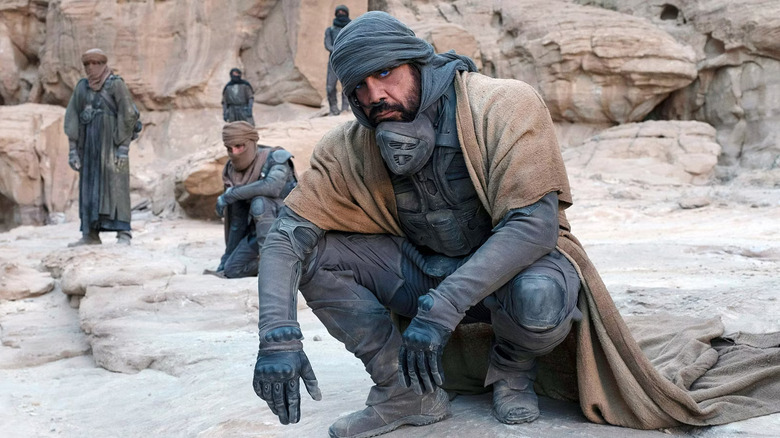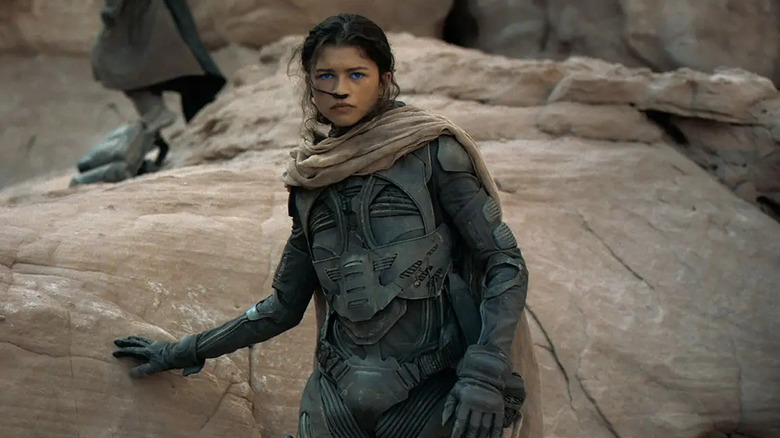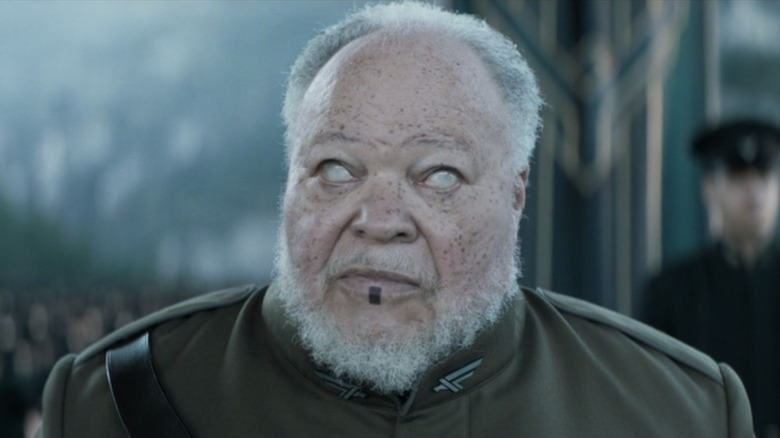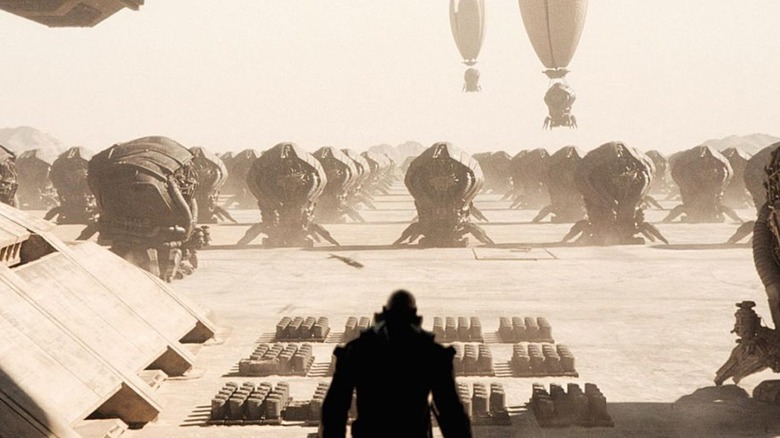We Rewatched Dune Part 1 And It's Totally Different Now
Director Denis Villeneuve's adaptation of Frank Herbert's "Dune" has quickly become one of the seminal experiences in 21st century cinema, with the two-part adventure wrapping up via the March 2024 release of "Dune: Part Two." That movie picks up with Paul Atreides already in exile, and carries the young protagonist's fledgling story through to the completion of his rise to power on the desert planet of Arrakis.
The second half of the story (Villeneuve doesn't consider the film a sequel) blew everyone away at the box office and has quickly drawn comparisons to previous fantasy successes, including Peter Jackson's "The Lord of the Rings" trilogy. With the success of the second part ringing in our ears, we decided to go back and rewatch the first half of the story again — and there's no doubt that it's a completely different viewing experience now.
With the second half providing some critical context, "Dune: Part One" takes on fresh life as now-beloved characters are introduced, events are set in motion, and Arrakis first comes into focus. Here are some of the biggest takeaways that come from a "Dune: Part One" rewatch now that "Dune: Part Two" is officially out.
What did Dune: Part One cover again?
Let's briefly recap how "Dune: Part One" introduces the characters and sets the stage for Denis Villeneuve's magnificent second installment in his cinematic world. "Dune: Part One" opens in the midst of a geopolitical shift as Arrakis changes hands from House Harkonnen to House Atreides, two of the mighty families of the Galactic Padishah Empire.
Paul (Timothée Chalamet), the heir of House Atreides, takes center stage as his family assumes control of Arrakis, which is known for its deserts and the rare substance known as spice that it contains. We learn that spice is both a popular psychotropic substance and a key tool in interstellar travel. Paul's mother, Lady Jessica (Rebecca Ferguson), is also revealed to be a member of the Bene Gesserit order, and we begin to see how that all-female secret society is setting the stage for a messianic figure to rise up and shake the foundations of the empire.
Once on Arrakis, the Atreides discover that they have been set up to fail. The head of the family, Duke Leto (Oscar Isaac), is betrayed, and his counterpart, Baron Vladimir Harkonnen (Stellan Skarsgård), recaptures Arrakis with the help of the Emperor's Sardaukar soldiers. By the time the sand settles, House Atreides and its followers are all but wiped out, and the Harkonnens have resumed their position on Arrakis. Paul and Jessica survive in the desert, where they ally with the indigenous Fremen inhabitants, setting the stage for the second half of the story.
Duncan Idaho's awesome adventure begins
Remember the spectacular arrival of Duncan Idaho (Jason Momoa) on Arrakis in Denis Villeneuve's first "Dune" film? Neither do we. When we meet Idaho, who is loyal to House Atreides, he's preparing to head to Arrakis with the advance team. After that, we don't see the guy until he emerges from the desert weeks later with Stilgar (Javier Bardem) in tow. We get a quick recap of how he was stalked by the Fremen, killed one of their warriors, and then wormed his way into their affections — but we don't see any of that happen.
It turns out that there were plans to include a sequence where Idaho arrives on the planet for a solo reconnaissance mission. Casually called the "Duncan drop" by the production crew, the partially-shot scene depicts Idaho dropping solo onto the planet's surface. He uses his tech-infused suit to land without a parachute before heading off into the wilderness to seek out the local Fremen and learn what he can before his masters arrive in his wake.
Sadly, Idaho's arrival was left on the cutting room floor along with several other "Dune" scenes. While there's no doubt that "Dune: Part One" begins on a strong note, it would have been awesome to see Idaho's adventure kick off — given his absence in "Part Two," his lack of a grand entrance in "Part One" now feels like a missed opportunity. Per producer Tanya Lapointe's book "The Art and Soul of Dune," Villeneuve removed the scene because it wasn't novel-accurate enough.
The Bene Gesserit are a really big deal
The Bene Gesserit order is a defining element of Frank Herbert's world. This hidden sisterhood is essentially the ultimate power, even in a universe with god-like emperors and powerful houses. They pull the strings from the shadows, plotting, scheming, and setting the course of history. But, while the Bene Gesserit are essential in the source material, they take on an even greater importance in Denis Villeneuve's adaptation. The director even revealed that he cut Stephen McKinley Henderson's character, the Mentat Thufir Hawat, from his second film specifically to prioritize the role of the mystics, telling Entertainment Weekly: "I decided right at the beginning that I was making a Bene Gesserit adaptation. That meant that Mentats are not as present as they should be."
This overt focus on the Bene Gesserit is clear in "Dune: Part Two," in which the sisterhood takes on an outsized role in directing the fate of the universe. The exceptional emphasis on the group is also more apparent in a rewatch of "Dune: Part One." Jessica is revealed as one of the order early on. Dr Yueh (Chang Chen) mysteriously refers to the group as serving the greater good — along with their own designs. The Reverend Mother Mohiam (Charlotte Rampling) also threatens Paul with the Gom Jabbar to test the powerful heir's impulses. After that event, she and Jessica discuss "The One," how the Bene Gesserit have many prospects, and how their plans are measured in centuries. Knowing what we do now, the Bene Gesserit definitely stand out more when you rewatch "Dune: Part One."
The Gom Jabbar scene doesn't go far enough
The Gom Jabbar test scene is famous. Even casual fans are aware of the pain-infused little box of horrors used in the test: Paul's encounter with the whirring device as he faces the Reverend Mother and her pointy poisoned needle is a defining moment in the book. In fact, it's the first thing you read (which means even those who don't get through the massive text are still familiar with the scene). The Gom Jabbar experience is nightmare fuel, and it's an exciting part of "Dune: Part One."
But did the scene in Denis Villeneuve's film go far enough? Do we see everything that the heir to House Atreides endures? During the first viewing, Paul stoically maintains his calm as he fights fear, the mind-killer. Relatively speaking, the young man maintains his composure throughout the scene. However, when you go back and watch the promotional footage for the movie, it turns out that we didn't get everything that Denis Villeneuve originally filmed.
The proof? In one of the trailers, we get a brief flash of Paul facing the Reverend Mother. Rather than maintaining his composure, he's shown screaming in agony. When you rewatch the movie, that scene is nowhere to be found. Cutting the footage honestly makes sense. If Paul moves his head in agony like that, there's a good chance the Gom Jabbar pricks him. Eliminating that shot was a good call — but apparently, it didn't happen until after they released the first trailer.
Paul really is caught in the gears of history
One thing that really stands out during a rewatch of "Dune: Part One" is Paul Atreides' unavoidable involvement in history. "Dune: Part Two" shows us a character who is slowly accepting his inevitable fate. He's surrounded by fanatical followers, incited to action by an overly involved mother figure, and pushed by the difficult circumstances of his exile. When Paul decides by the end of "Dune: Part Two" to go all in on an attempt to take control of the Empire, it makes sense. He's clearly bought into his own story (or at least his ability to use that story for his own benefit).
In "Dune: Part One," this bloodthirsty, war-mongering protagonist is nowhere to be found. Instead, we meet a young aristocrat in training who is just beginning to realize that others have already planned out his life for him. Even late in the movie, he is just starting to wake up to his reality. He rages against his mother and the Bene Gesserit for making him a freak and hesitates to make his first kill when fighting Jamis (Babs Olusanmokun).
When rewatching "Dune: Part One" after seeing "Dune: Part Two," Paul's inevitable involvement in galactic events becomes a defining part of the narrative. The young man is clearly caught in the gears of history, and looking back, it's a little sad to see a version of Paul who still believes that he has any choice in the matter — his path has already been determined, and he will soon realize that he has no choice but to walk it.
The bull imagery matters
Eagle-eyed viewers may notice on a rewatch of "Dune: Part One" that there is a string of shots with bulls in them. From bull heads mounted on a wall to miniatures of little matadors fighting their pointy-horned opponents, the bull motif is all over the movie, specifically in relation to House Atreides. This is a direct reference to the Old Duke, Leto's father and Paul's grandfather, who fought bulls for sport. He even met his fate on the horns of one. We get a brief glimpse of this past event when Paul and his father visit the Old Duke's grave before leaving Caladan — there, on the headstone, is a depiction of a bullfight.
This obsession with archaic, barbaric violent sports isn't unique to the Atreides. "Dune: Part Two" has an extended sequence showing the Harkonnens' own obsession: gladiatorial games. The first time we see Feyd-Rautha Harkonnen (Austin Butler) in action, the skilled fighter is dueling opponents in an arena so big it would make a Roman emperor jealous. Herbert's story may take place thousands of years in the future, but one thing hasn't changed: Humans can be cruel. Given enough time, they always circle back to violent competitions, and the Atreides' bull imagery is a subtle testament to that fact. As Paul learns himself when the truth of his lineage is revealed in "Dune: Part Two," House Harkonnen and House Atreides aren't that different, and this is a lot more clear upon a rewatch of the first film.
The movie could (and should) have been a lot longer
Together, the two halves of Denis Villeneuve's "Dune" add up to well over five hours of runtime. Generally, the first half of a two-part story is the part that feels slow. Even so, "Dune: Part One" flies by. Despite the lack of a true climax and its cliffhanger ending, the movie expertly entertains from beginning to end. It's a masterclass in introducing an ensemble cast and world-building on a huge scale without losing your audience.
That being said, we now know that the film could (and probably should) have been longer. It's rare that an initial vision for a film makes it to the big screen totally unchanged, even more so for big blockbusters like the "Dune" films. Studios want the movie to flow to help with audience retention, and that's totally understandable. However, since "Dune: Part One" came out, more and more details about what was cut have emerged. Armed with this knowledge, the film definitely hits differently upon a rewatch.
The list of deleted scenes includes everything from Jessica training Paul in the ways of the Bene Gesserit to the moody Gurney Halleck (Josh Brolin) playing a fictional instrument called the baliset. Pretty much all of these scenes would have added depth to the characters involved and helped to flesh out the world. Don't expect to see any of them, though: Villeneuve doesn't believe in director's cuts, so the experience won't get any longer, at least until a third movie is made (but don't hold your breath on seeing a third "Dune" film any time soon).
Paul ages oddly
Not much time passes between the stories of "Dune: Part One" and "Dune: Part Two." As such, the characters should look pretty much exactly the same. However, there were multiple years between filming since the new "Dune" films were not shot back to back. In contrast, past tentpole events like Peter Jackson's "The Lord of the Rings" films or Marvel's "Avengers: Infinity War" and "Avengers: Endgame" were filmed at the same time.
While this wasn't the case with "Dune," most of the actors look relatively the same, despite the years between productions. However, there's a noticeable difference in Timothée Chalamet's physical appearance. The fact that he looks more mature in "Dune: Part Two" actually plays into Paul's character arc — Paul is more assured in the follow-up, and that seems to mask the fact that Chalamet looks older. When you go back and watch "Part One," however, it becomes clear just how much the actor changed between the two films.
Kynes sees Paul's potential from the jump
Dr. Liet-Kynes (Sharon Duncan-Brewster) plays an important role in helping Paul and Jessica escape during the Harkonnen sacking of the capital city of Arrakeen. However, the blue-eyed Imperial Ecologist first enters the story in a meaningful way shortly after the Atreides arrive on Arrakis.
During this initial encounter, Kynes checks everyone's stillsuits. As she does so, she notes that Paul put his on correctly by himself. He's fitted his desert boots slip-fashion at the ankles. This is a veteran move worthy of a local Fremen, and Kynes inquires how the young lordling learned to put on his suit that way. Paul's response is that he's never worn a stillsuit before, adding, "It seemed the right way." At that, Kynes mutters under her breath, "He shall know your ways as though born to them," and the scene moves on from there.
This is easy to miss on the first watch. Doubling back after seeing "Dune: Part Two," though, it turns out that the scene is filled with deeper meaning. Paul's prophecy-infused future centers on rising to lead the Fremen, and this isn't possible without his ability to display comfort with and an understanding of their ways. Kynes' prescient reference to past sayings is a deliberate call-out to Paul's future leadership over the Fremen. However, the fact that it's muttered under her breath in the middle of more important matters makes the line easy to miss on the first watch.
Kynes' words about a green Arrakis
When Paul and Jessica flee from the Harkonnen assault in "Dune: Part One," they take shelter with Dr. Kynes at an old ecological testing station. On first watch, the location is pretty irrelevant, as the focus is on Paul and Jessica's survival. However, when you're watching the first film for a second time — especially after having seen "Dune: Part Two" — the backstory of the desert hiding place takes on more meaning. Kynes points out that the station was created to tame the planet and free the sand-locked water below the surface. She talks about how Arrakis could have been turned into a green paradise, but the discovery of spice derailed the terraforming efforts.
This unfulfilled promise of a greener Arrakis indirectly points to a major theme of "Dune: Part Two." In the second half of the story, Paul specifically identifies as the Lisan al Gaib, the so-called Voice from the Outer World who will function as a sort of messiah for the Fremen. Part of that messianic prophecy is the idea that he will be the Giver of Water for the Fremen and will lead them to paradise. Essentially, he will do what scientists could have done had it not been for the greed that spice cultivated in the Empire. Little did we know at the time, but Kynes was telling Paul all about the details of the prophecy without realizing she was talking to the person destined to deliver it.
Stilgar's meaningful line
At the end of "Dune: Part One," Paul and Jessica finally connect with the Fremen. The initial encounter isn't a cakewalk, though, as Paul is quickly challenged to a duel by the hot-headed Jamis. He gets the better of Jamis more than once, but he doesn't kill him, expecting him to yield.
As he watches, Stilgar observes aloud, "The boy doesn't know our rule. There's no yielding under the amtal rule. Only death is the test of it." This is a shock to Paul and Jessica, and when Stilgar asks the latter, "Is he toying with him?" Jessica points out that Paul has never killed a man before. This turns out to be an amalgamation of two lines from Frank Herbert's books, in which Stilgar says, "Have an end to it, lad" and "Don't play with him."
When rewatching this after viewing "Dune: Part Two," the entire scene takes on more meaning. The revelation of Paul's battlefield innocence means that until the final moments of "Part One," he's never made a kill. And yet, shedding blood, both through others and by his own hand, becomes part and parcel of his identity in the second half of the story. Even his trip south of the equator of Arrakis is predicated on his prescient knowledge that horrific bloodshed will ensue. Jamis' return in a vision to help guide his decision when he's on the fence about becoming the Lisan al Gaib also makes their original duel a bigger deal than it seems on a first watch.
Paul's visions of Chani
One of the recurring elements of "Dune: Part One" is Paul's recurring visions of Chani before he knows who she is or why she keeps showing up in his dreams. When the Reverend Mother asks him about them, he simply says that he saw "a girl, on Arrakis. Many times." When asked if his dreams often come true, though, he replies, "Not exactly," leaving the audience wondering what part of his visions will come true — and in what way.
Some of the visions show Chani walking in slow motion, beckoning Paul and smiling at him in a vague manner. Others get more specific, like the time he sees a holy war spreading across the universe, led by himself, with fanatical legions waving the Atreides banner. Chani is there with him, but she doesn't look happy. At another point, Paul follows Chani. They kiss, and then she stabs him with a crysknife.
All of this is confusing until you see "Dune: Part Two." In that film, all of the imagery of attraction, conflict, and eventual betrayal come into focus. Paul and Chani have a romantic storyline throughout the film. As he steps into his destiny as the Kwisatz Haderach, Chani becomes a resister and an obstacle to his rise to power. She reluctantly saves his life with her tears but ultimately rejects him as he makes his bid for power. It's all there, hidden in "Dune: Part One," and it's much easier to see the second time around.
Thufir Huwat was supposed to be more involved
At the risk of sounding overly simplistic, the Dune universe doesn't have computers or artificial intelligence, due to an ancient war between humanity and AI known as the Butlerian Jihad. Instead, there are Mentats, the equivalent of a biological super-computer. They are humans who can run calculations and fill the gap of banned technology. The Great Houses have their own Mentats, and Thufir Hawat (Stephen McKinley) fills that role for the Atreides in "Dune: Part One."
Hawat is a minor character throughout the movie, but a rewatch reveals that he actually should have been more involved. Hawat plays a key role in Herbert's books, and Denis Villeneuve has revealed that he cut the character from "Dune: Part Two" as a painful but necessary part of adapting the source material.
In that film, Hawat was supposed to conspire to divide the Harkonnens and disrupt them from within. But in a 2021 interview, McKinley pointed out that his role in "Dune: Part One" was also cut down from the original plan. The actor explained that the original script has more dialogue between Paul and Hawat, highlighting the instrumental role the Mentat plays in Paul's training — and his ability to survive the first film's assassination attempt by the hunter-seeker. None of this is there in the first watch, but the deleted scenes would have absolutely done more to put Hawat in the limelight — an absence that is painfully and obviously missing during a rewatch.
Villeneuve really likes cliffhanger endings
One of the most upsetting things about "Dune: Part One" was the sudden and unexpected way it ended. Paul and Jessica have just proven that the Fremen shouldn't disregard them, and they are traveling with Stilgar, Chani, and company to the local sietch to further consider their potential acceptance into the Fremen community. The abrupt ending feels sudden, but that's excusable, as the movie is the first installment of a two-part story. Surely, the director will wrap things up in the second half. Right?
After a rewatch of "Dune: Part Two," though, it becomes clear that director Denis Villeneuve doesn't mind leaving audiences in the lurch. In fact, the unexpected ending of "Dune: Part One" is part of a pattern. Both films end on a cliffhangers. In the second movie, we get another mid-action ending. In that film, we see Fremen-filled ships flying up to launch an all-out war on the universe. Chani is angry and goes off on her own to lasso a sandworm. Then it all just ends.
Although this — with some notable differences — is more or less where the novel ends as well, there isn't any real conclusion. "Dune" may be a sprawling story, and that makes it easier to always leave the door open for more storytelling. But rewatching "Part One" confirms the fact that Villeneuve is clearly comfortable with leaving anxious audiences with a desperate lack of closure as they work their way through his interpretation of this fan-favorite sci-fi landmark.
